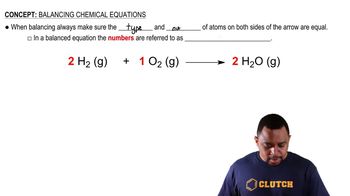Write the balanced chemical equation for each reaction. c. Aqueous hydrochloric acid reacts with solid manganese(IV) oxide to form aqueous manganese(II) chloride, liquid water, and chlorine gas.
Ch.3 - Molecules, Compounds & Chemical Equations
Chapter 3, Problem 108b
Write the balanced chemical equation for each reaction. b. Solid iron(III) oxide reacts with hydrogen gas to form solid iron and liquid water.
 Verified step by step guidance
Verified step by step guidance1
Step 1: Write down the unbalanced chemical equation. In this case, the reactants are solid iron(III) oxide (Fe2O3) and hydrogen gas (H2), and the products are solid iron (Fe) and liquid water (H2O). So, the unbalanced equation is: Fe2O3(s) + H2(g) → Fe(s) + H2O(l)
Step 2: Balance the equation by adjusting the coefficients in front of the chemical formulas. Start by balancing the elements that appear in only one compound on each side. In this case, start with iron (Fe). There are 2 Fe atoms in Fe2O3 on the left side, so put a coefficient of 2 in front of Fe on the right side: Fe2O3(s) + H2(g) → 2Fe(s) + H2O(l)
Step 3: Next, balance the hydrogen atoms. There are 2 H atoms in H2 on the left side and 2 H atoms in H2O on the right side, so the hydrogen atoms are already balanced.
Step 4: Finally, balance the oxygen atoms. There are 3 O atoms in Fe2O3 on the left side and 1 O atom in H2O on the right side. To balance the oxygen atoms, put a coefficient of 3 in front of H2O on the right side: Fe2O3(s) + H2(g) → 2Fe(s) + 3H2O(l)
Step 5: Now, recheck the hydrogen atoms since we have changed the number of H2O molecules. There are 2 H atoms in H2 on the left side and 6 H atoms in 3H2O on the right side. To balance the hydrogen atoms, put a coefficient of 3 in front of H2 on the left side: Fe2O3(s) + 3H2(g) → 2Fe(s) + 3H2O(l). Now, the equation is balanced.

Verified Solution
Video duration:
0m:0sWas this helpful?
Key Concepts
Here are the essential concepts you must grasp in order to answer the question correctly.
Balancing Chemical Equations
Balancing chemical equations involves ensuring that the number of atoms of each element is the same on both sides of the equation. This is based on the law of conservation of mass, which states that matter cannot be created or destroyed in a chemical reaction. To balance an equation, coefficients are adjusted in front of the chemical formulas to achieve equal atom counts.
Recommended video:
Guided course

Balancing Chemical Equations
Types of Chemical Reactions
The reaction described is a redox reaction, where oxidation and reduction occur simultaneously. In this case, iron(III) oxide (Fe2O3) is reduced to iron (Fe), while hydrogen gas (H2) is oxidized to water (H2O). Understanding the roles of oxidizing and reducing agents is crucial for identifying the changes in oxidation states during the reaction.
Recommended video:
Guided course

Common Types of Alkane Reactions
States of Matter in Chemical Reactions
In chemical equations, the physical states of the reactants and products are indicated using symbols: (s) for solid, (l) for liquid, and (g) for gas. This information is important for understanding the conditions under which the reaction occurs and can affect the reaction's feasibility and rate. In the given reaction, solid iron(III) oxide and hydrogen gas react to produce solid iron and liquid water.
Recommended video:
Guided course

Element States of Matter
Related Practice
Textbook Question
1451
views
Textbook Question
Write the balanced chemical equation for each reaction. d. Liquid pentane (C5H12) reacts with gaseous oxygen to form carbon dioxide and liquid water.
1422
views
1
rank
Textbook Question
Write the balanced chemical equation for each reaction. a. Solid copper reacts with solid sulfur to form solid copper(I) sulfide.
2046
views
Textbook Question
Write the balanced chemical equation for each reaction.
c. Sulfur dioxide gas reacts with oxygen gas to form sulfur trioxide gas.
d. Gaseous ammonia (NH3) reacts with gaseous oxygen to form gaseous nitrogen monoxide and gaseous water.
1344
views
Open Question
Write the balanced chemical equation for the reaction between aqueous sodium carbonate and aqueous copper(II) chloride to form solid copper(II) carbonate and aqueous sodium chloride.
Textbook Question
Write the balanced chemical equation for the reaction of aqueous potassium hydroxide with aqueous iron(III) chloride to form solid iron(III) hydroxide and aqueous potassium chloride.
925
views
